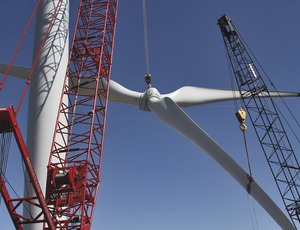Settlers Trail Wind Farm was constructed during extremely cold winter weather, with crews fighting freezing rain, snow and temperatures as low as -20˚F.


Building a wind farm is inherently dangerous due to, well, the wind. Despite the cold snap, crews managed to pour foundations for the 96-turbine project. Although spring weather brought some relief, erection crews still battled the winds.
In all, crews for the 20,000-acre installation lost 25 days to high winds, though the contract only allowed for 10.
Longer work days were required to keep the project on schedule. When winds howled during the day, crews worked at night. When forecasts projected calmer winds, they shifted to weekends to make up lost time. With both the weather and schedule churning, safety was paramount during construction.
Among other measures, job hazard analyses were required for each crew member, each day, prior to commencement of work. Accordingly, each supervisor met briefly with individual crew members to identify potential hazards through the course of the day.
Likewise, weekly "all hands" meetings notified crews of activities scheduled to occur on site and related hazards they might encounter during the week.
White Construction, the project's contractor, requires all supervisors to be trained in accordance with its behavioral-based safety program, and the Settlers Trail project was no exception.
A safety steering committee comprising the owner's senior field supervisors, White Construction management, representatives from all subcontractors and key craft personnel met biweekly to evaluate jobsite safety and address related concerns.
In addition, the contractor distributed special awards to the crews when they achieved periodic safety milestones.
In all, the project logged 151,574 working hours while achieving OSHA and lost-time rates of zero.


Post a comment to this article
Report Abusive Comment